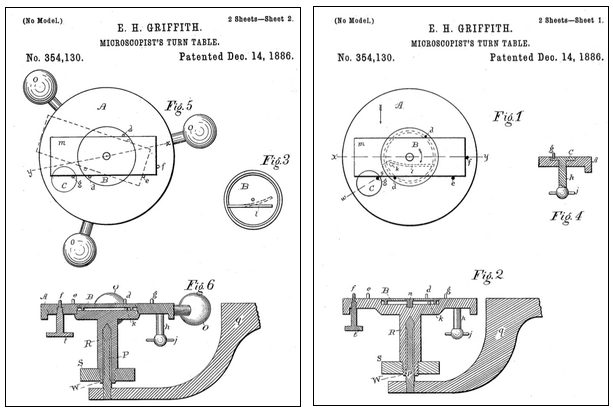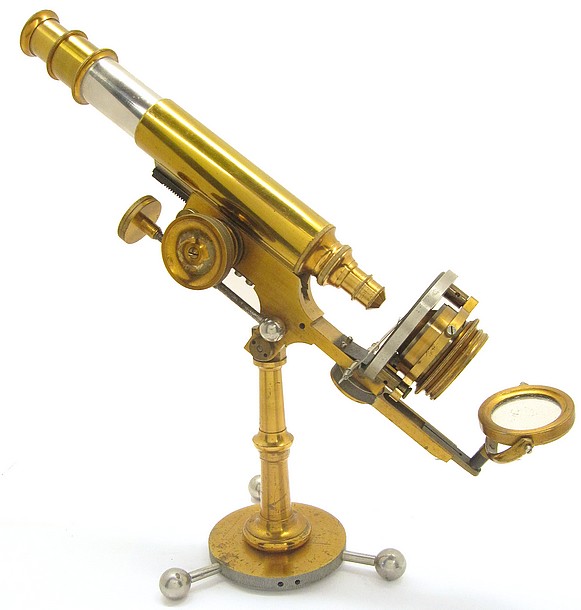
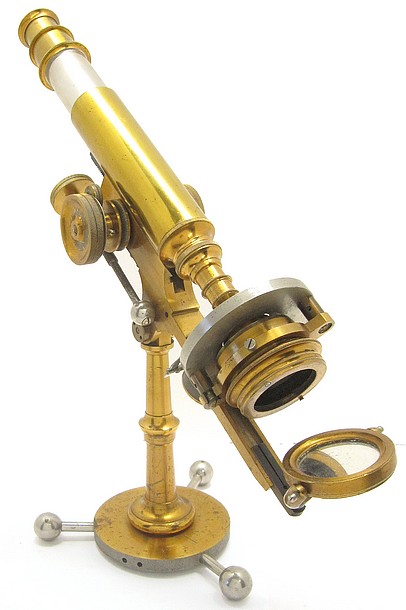
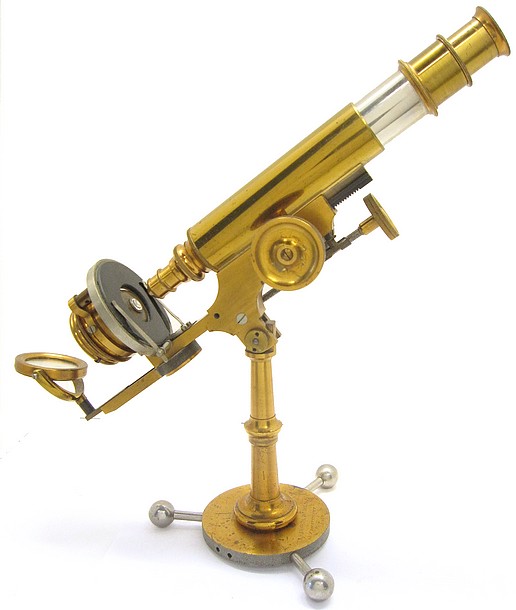
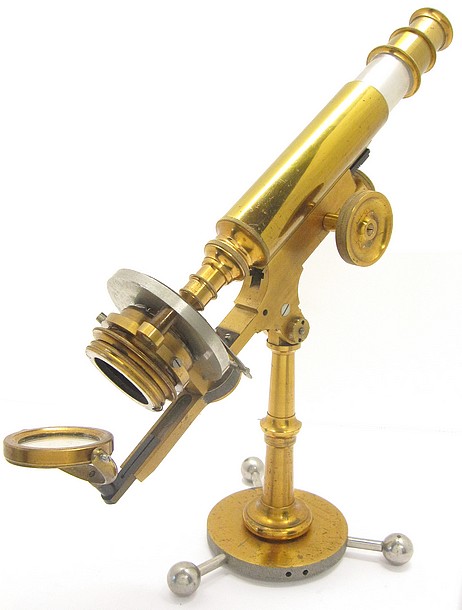
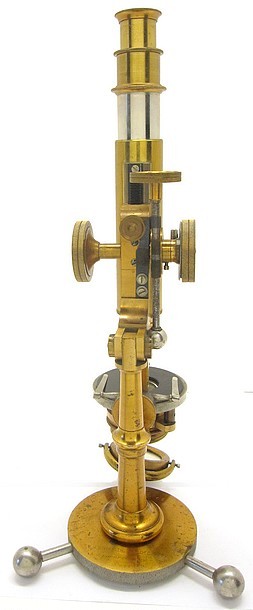
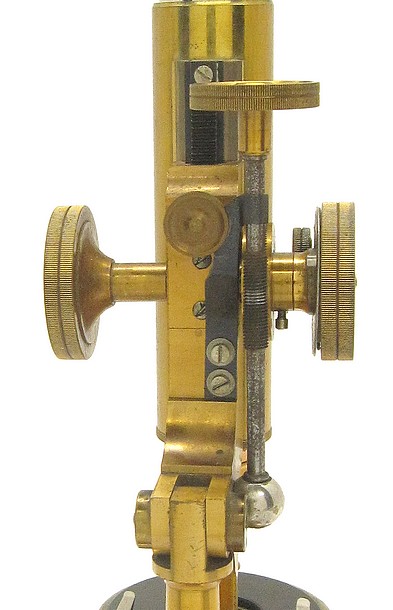
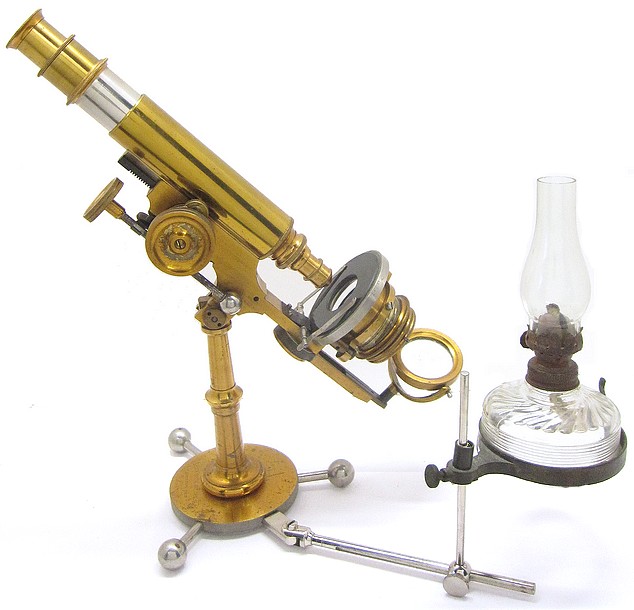
The microscope is shown with the nickel plated fittings that are used to attach an oil lamp to the microscope. While the oil lamp and its holder pictured are not original equipment, they are included here to illustrate how a lamp can be mounted.
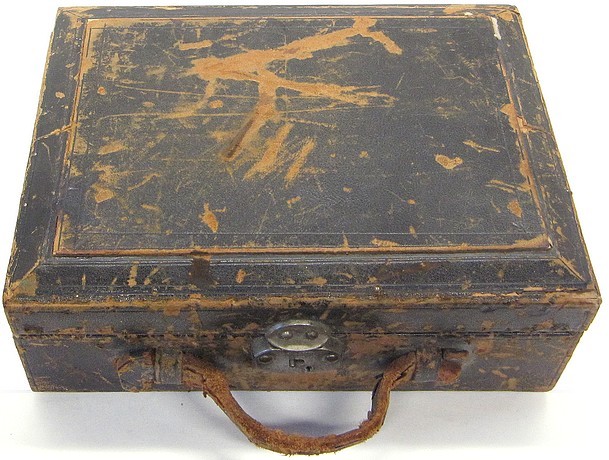
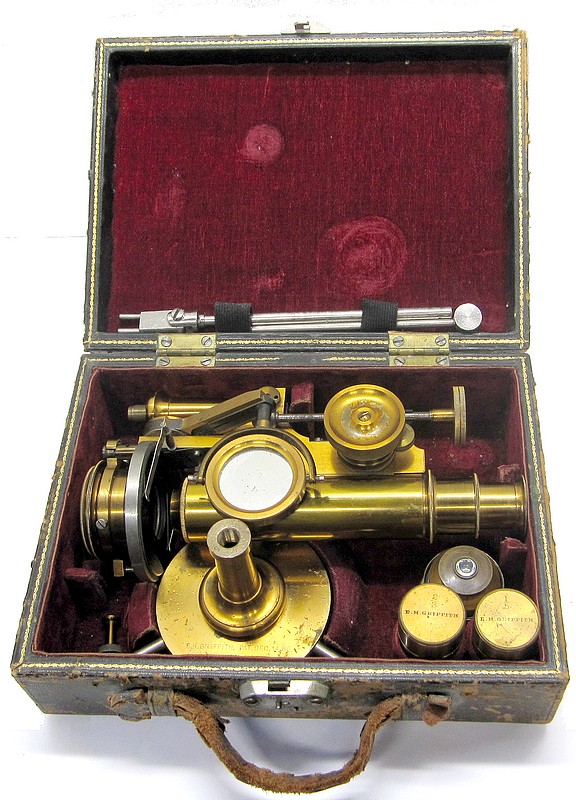
Among the accessories supplied with this microscope are two Griffirth objectives, a 2/3 and a 1/5 with canisters, one eyepiece labeled B, a sub-stage fitting having a Society Screw, and an Abbe condenser. Also, included are the nickel plated fittings that are used to mount an oil lamp. Everything is stored in a wood case having back leather covering and plush mauve lining.
The following was extracted from The Journal of the Royal Microscopical Society, 1883:
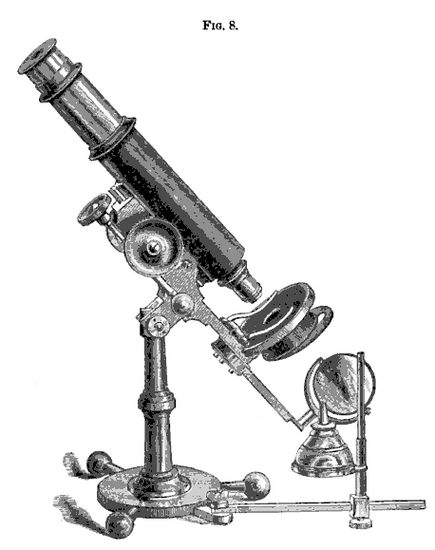
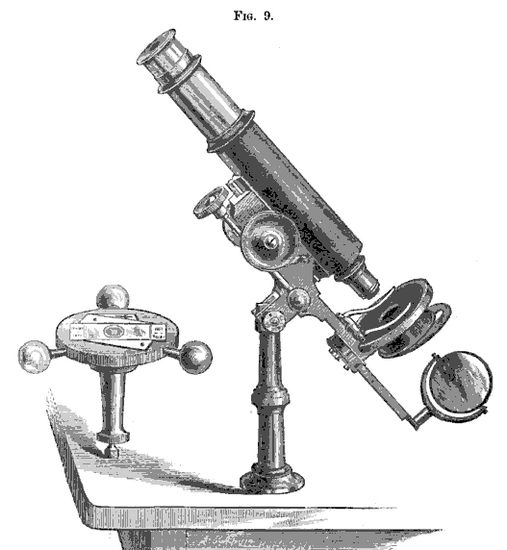
Improved Griffith Club Microscope: (Proc. Amer. Soc. Micr., 5th Annual Sleeting, 1882, pp. 149-52, Ser. 2, Vol. III). The original "Griffith Club Microscope" was described in Vol. I. (1881) p. 293. Since that time important changes have been made by Mr. E. H. Griffith, so that very little of the original form is left, as will be seen on comparing figs. 8 and 9 with the earlier illustrations. It retains its original name in appreciation of the honour conferred on the inventor by the " Griffith" Clubs of Detroit and Danville, U.S.A. It is a full-sized instrument and the main and draw tubes have the Society screw. The coarse adjustment is effected by rack and pinion on the "Jackson" principle, and has about 3 in. of motion. The fine adjustment, which appears to be both simple and efficient, is effected by the application of a worm-wheel and tangent-screw to the axis of the pinion of the coarse adjustment. The worm-wheel is on this axis, near the limb, and it is acted upon by the tangent-screw being sprung against it, the milled head of which is shown behind the limb in fig. 8. When the coarse adjustment is in use, a " snail "-shaped lever on the right of the limb (handle shown beneath the large milled head) forces the tangent-screw from contact with the worm-wheel, a spring latchet locking it in position (for the example represented in this collection, a different mechanism is used to engage the fine adjustment (see below)). By releasing the " snail" lever the tangent-screw is pressed into the worm-wheel, and acts upon the coarse adjustment so slowly that objectives of high power can be focused with it. It will of course be understood that when the tangent-screw is sprung against the worm-wheel the coarse adjustment is no longer operative, which Mr. Griffith considers to be a protection against breakage of slides. A similar system of fine focusing was adopted in England many years ago, and is still used in some of Plossl's models. The stage clips are supported on a bar above the stage, allowing the slide to make almost a complete revolution. The mirror-bar is adjustable in length, and the mirror can be set at any angle above or below the stage, allowing any obliquity of illumination for opaque and for transparent objects. The standard divides midway between the body and the foot, and the base may be detached, and the body set on an extra standard (fig. 9), with a screw at the end for fixing it in a tree, laboratory table, &c. The base being inverted and placed on a spindle, which is always in position in the box, becomes a turntable, provided with self-adjusting clips for holding the slide. Three rods, with silvered balls at one end, are the supports for the Microscope, and they give momentum to the turntable when in use. Two small holes in the edge of the turntable foot allow the attachment of an adjustable lamp-holder, which is furnished with a lamp for class, lecture, and exhibition use. A case about 7 in. long, 5 in. wide, and 3 in. deep, internal measure, holds the instrument when packed (fig. 10), and it may be taken down and packed for travelling or be taken from the box and set up ready for use in a few seconds, " making the Microscope not only a first-class monocular for home and office use, but also for the tourist and the naturalist." The Bausch and Lomb Optical Company are the makers.
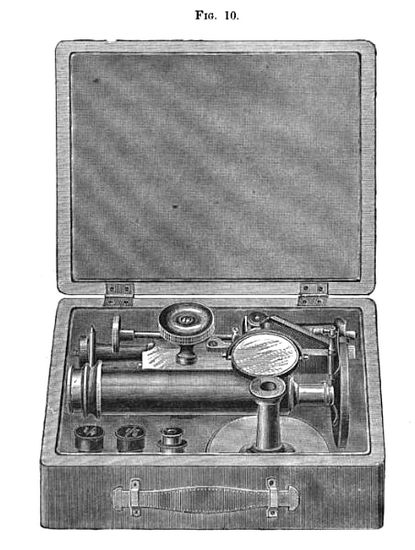
The method of engaging fine adjustment mechanism used on the later example shown on this page is different than the more simple mechanism described in the above extract from the JRMS. This newer mechanism allows the fine and coarse to be engaged simultaneously. The new mechanism was illustrated and described by Griffith in an article published in the American Monthly Microscopical Journal, 1889 as follows:
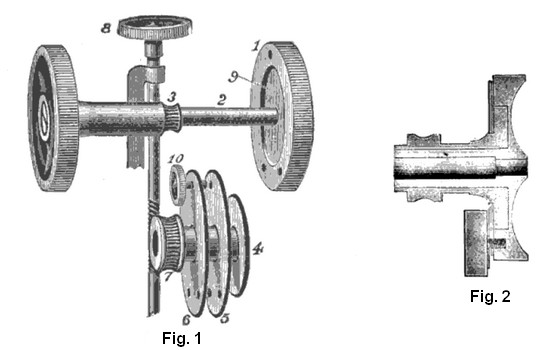
Griffith’s Fine Adjustment.
By E. H. GRIFFITH, FAIRPORT, N. Y.
In Fig 1 Nos. (1) (2) (3) represent the milled head, pinion-axis, and pinion of the ordinary method of coarse adjustment. The milled head (1) is countersunk on its inner side, and the small wheel (4) is made to exactly fit the countersunk space, the inner surface of (1) and of the wheel (4) being perfectly smooth and flat. Attached to (4) is the socket and pinion (7), all of which are perfectly fitted over the pinion-axis (2) between the pinion (7) and milled head (1). A leather washer (5) is made to rest closely against the inner surfaces of ( 1 ) and (4). It is held in position bv another washer of metal (6) which, by means of two screws passing through it and (5) is made fast to the milled head. A small tension wheel (10) has a screw passing through both washers, also binding them to (1), and when desired, locking the coarse-adjustment by making the whole combination practically one wheel. When the coarse-adjustment is used, the spindle (8) holds (7). (6), (5), (4), so that they cannot revolve with the pinion. When the micrometer adjustment is required the friction of the leather washer makes the whole combination practically one wheel, which is turned by means of the milled head (8), giving the entire range of the coarse adjustment for the fine adjustment. Both adjustments are always ready for use when the tension wheel is properly set, except when the coarse adjustment is purposely locked to prevent accidents. All wear is taken up by the spring. Fig. 2 shows the entire combination in position. In this combination of the two adjustments into one, but one groove is required, greatly lessening the danger of lateral motion as in other microscopes where two or more grooves are needed. The one groove being close to the tube is another safeguard.
The long range of the fine adjustment is of great value, and the same is claimed for the locking device. The mechanism is so simple that it cannot well get out of order, and should any accident happen, any jeweller could easily repair it.
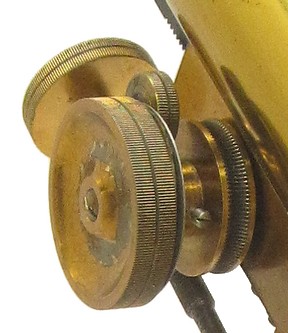
There are some additional refinements included with the later version of the Club Microscope shown on this page that are not present in the earlier examples described in the above Griffith article or the JRMS extract. In particular, the circular pinion socket (7) shown in Fig. 1 of the Griffith article has been given a larger diameter which results in slowing down the fine adjustment making it more sensitive. Compare the circular pinion sockets on Club microscopes with serial numbers 957 and 840.
With this later vintage Club Microscope, the sub-stage is attached to the stage in a different manner so that it can be removed more easily. Now, incorporated into the design of the sub-stage is a focusing arrangement consisting of a spiral screw tract cut directly into the mount. Turning the milled edge of the mount focuses the condenser.
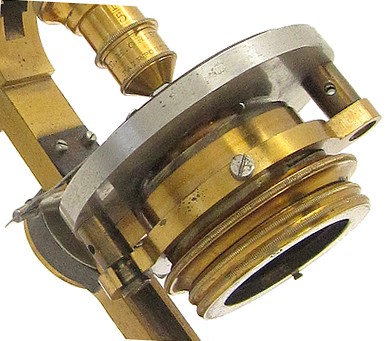
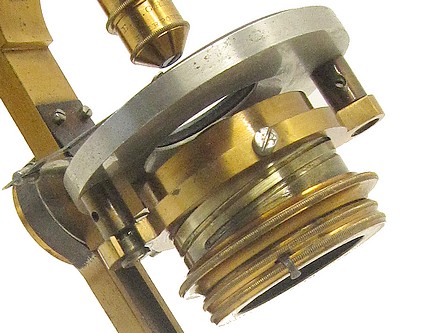
The microscope shown on this page differs from the final version of the Griffith microscope that is described in Proceedings of the American Microscopical Society, Vol. 14, No. 1, pp. 53-56, 1892. The sub-stage is still attached to the stage and not attached to the tail piece of the limb as in the final version. The centering adjustment of the sub-stage, present in the final version, is absent on the microscope shown here. A diagonal rack was used in the final version, while the microscope on this page retains a straight rack.
Another Griffith Club Microscope with serial number 840 is also in this collection. It differs from the present example primarily with respect to the sub-stage and having the faster type of fine adjustment.
